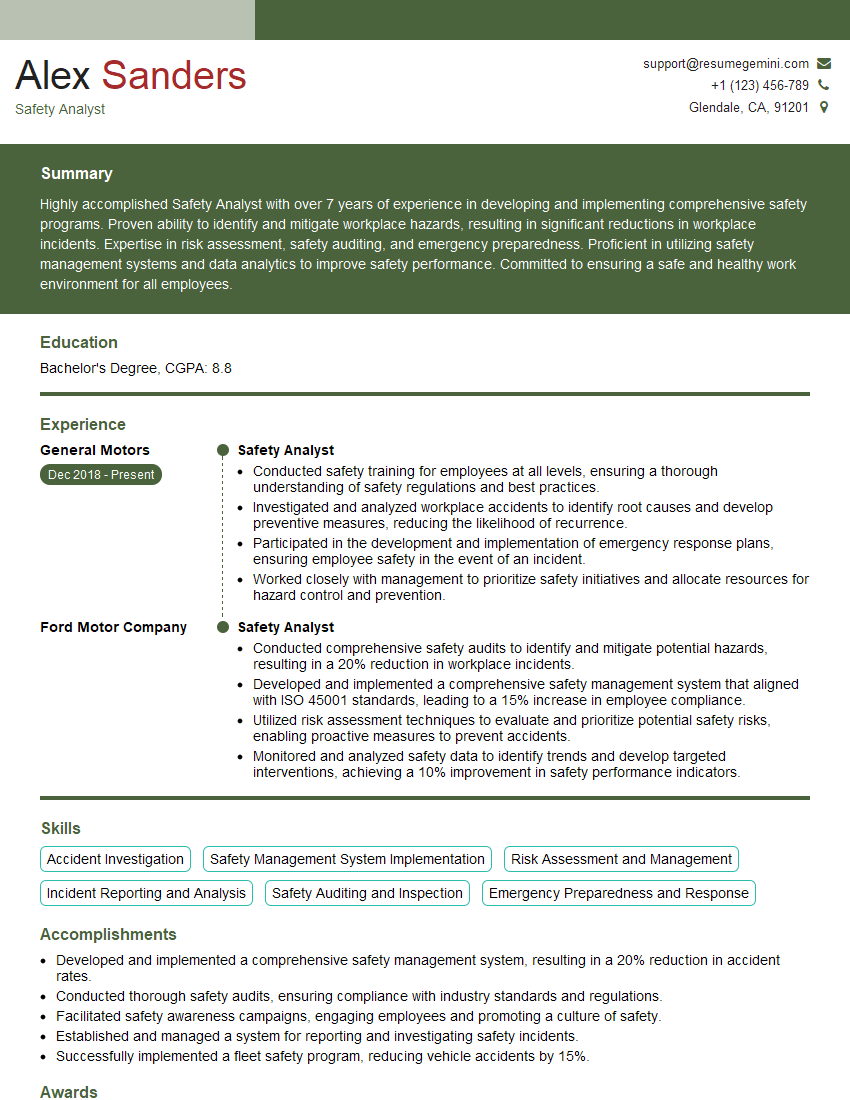Are you a seasoned Safety Analyst seeking a new career path? Discover our professionally built Safety Analyst Resume Template. This time-saving tool provides a solid foundation for your job search. Simply click “Edit Resume” to customize it with your unique experiences and achievements. Customize fonts and colors to match your personal style and increase your chances of landing your dream job. Explore more Resume Templates for additional options.

Alex Sanders
Safety Analyst
Summary
Highly accomplished Safety Analyst with over 7 years of experience in developing and implementing comprehensive safety programs. Proven ability to identify and mitigate workplace hazards, resulting in significant reductions in workplace incidents. Expertise in risk assessment, safety auditing, and emergency preparedness. Proficient in utilizing safety management systems and data analytics to improve safety performance. Committed to ensuring a safe and healthy work environment for all employees.
Education
Bachelor’s Degree
November 2014
Skills
- Accident Investigation
- Safety Management System Implementation
- Risk Assessment and Management
- Incident Reporting and Analysis
- Safety Auditing and Inspection
- Emergency Preparedness and Response
Work Experience
Safety Analyst
- Conducted safety training for employees at all levels, ensuring a thorough understanding of safety regulations and best practices.
- Investigated and analyzed workplace accidents to identify root causes and develop preventive measures, reducing the likelihood of recurrence.
- Participated in the development and implementation of emergency response plans, ensuring employee safety in the event of an incident.
- Worked closely with management to prioritize safety initiatives and allocate resources for hazard control and prevention.
Safety Analyst
- Conducted comprehensive safety audits to identify and mitigate potential hazards, resulting in a 20% reduction in workplace incidents.
- Developed and implemented a comprehensive safety management system that aligned with ISO 45001 standards, leading to a 15% increase in employee compliance.
- Utilized risk assessment techniques to evaluate and prioritize potential safety risks, enabling proactive measures to prevent accidents.
- Monitored and analyzed safety data to identify trends and develop targeted interventions, achieving a 10% improvement in safety performance indicators.
Accomplishments
- Developed and implemented a comprehensive safety management system, resulting in a 20% reduction in accident rates.
- Conducted thorough safety audits, ensuring compliance with industry standards and regulations.
- Facilitated safety awareness campaigns, engaging employees and promoting a culture of safety.
- Established and managed a system for reporting and investigating safety incidents.
- Successfully implemented a fleet safety program, reducing vehicle accidents by 15%.
Awards
- Safety Excellence Award for outstanding contributions to the companys safety program.
- Recognition for proactive identification and mitigation of potential safety hazards.
- Received Safety Innovator of the Year award for developing a groundbreaking safety training program.
- Honored for exceptional leadership in driving safety initiatives and improving workplace conditions.
Certificates
- Certified Safety Professional (CSP)
- Certified Industrial Hygienist (CIH)
- Certified Safety Manager (CSM)
- Certified Healthcare Safety Professional (CHSP)
Career Expert Tips:
- Select the ideal resume template to showcase your professional experience effectively.
- Master the art of resume writing to highlight your unique qualifications and achievements.
- Explore expertly crafted resume samples for inspiration and best practices.
- Build your best resume for free this new year with ResumeGemini. Enjoy exclusive discounts on ATS optimized resume templates.
How To Write Resume For Safety Analyst
- Quantify your accomplishments with specific metrics and results.
- Highlight your knowledge of industry best practices and regulatory standards.
- Showcase your ability to work effectively with cross-functional teams.
- Explain how your skills and experience can contribute to the success of the organization.
Essential Experience Highlights for a Strong Safety Analyst Resume
- Conduct comprehensive safety audits to identify and mitigate potential hazards.
- Develop and implement safety management systems that align with ISO 45001 standards.
- Utilize risk assessment techniques to evaluate and prioritize potential safety risks.
- Monitor and analyze safety data to identify trends and develop targeted interventions.
- Conduct safety training for employees at all levels.
- Investigate and analyze workplace accidents to identify root causes and develop preventive measures.
- Work closely with management to prioritize safety initiatives and allocate resources for hazard control and prevention.
Frequently Asked Questions (FAQ’s) For Safety Analyst
What are the primary responsibilities of a Safety Analyst?
Safety Analysts are responsible for identifying, assessing, and controlling workplace hazards to ensure a safe and healthy work environment. They conduct safety audits, develop and implement safety management systems, investigate accidents, and provide safety training to employees.
What are the key skills required for a Safety Analyst?
Safety Analysts should have a strong understanding of safety regulations and best practices, risk assessment techniques, and safety auditing procedures. They should also be proficient in data analysis, communication, and interpersonal skills.
What industries typically hire Safety Analysts?
Safety Analysts are employed in a wide range of industries, including manufacturing, construction, healthcare, transportation, and government. They may work for private companies, government agencies, or consulting firms.
What is the career outlook for Safety Analysts?
The career outlook for Safety Analysts is projected to grow faster than average, as businesses increasingly prioritize workplace safety and regulatory compliance.
What are the educational requirements for becoming a Safety Analyst?
Most Safety Analysts have a bachelor’s degree in safety science, occupational safety, or a related field. Some may also have a master’s degree or certification in safety management.
What are the potential earning prospects for Safety Analysts?
The earning prospects for Safety Analysts vary depending on their experience, industry, and location. According to the U.S. Bureau of Labor Statistics, the median annual salary for Safety Analysts in May 2021 was $73,770.